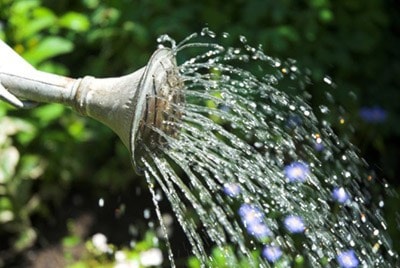It’s been a challenging year for so many plants in our gardens and landscapes but some situations need immediate attention. We’re discovering, as never before, the true value of water in our gardens. What is also an issue is proper soil preparation for all plants as water stress shows up far more quickly in soils that were never properly prepared, and as a result, many plants will have great difficulty surviving.
At this critical stage, with continuing record-breaking drought since February, how do we deal with this situation? Wisdom, observation and prioritizing where water is needed most are the keys. We also have to respect rapidly changing water restrictions as regulated in every community.
Trees that are under stress must get attention first. They are huge environmental allies that not only cool us but also sequester carbon, produce oxygen and collect pollution – and that’s just for starters. When watering is allowed, we must get soaker hoses around the drip lines and water as often and as deeply as we can. This is especially true of shallow rooted hedging plants like cedars. Once you have watered, dig down to see how far it has penetrated into the soil. Wetting the top few inches is not adequate as you must get a good level of moisture down to the roots – it’s a matter of life and death. Even when using drip systems, in this continuing heat we need to check for adequate moisture levels.
Plants of any type in containers are particularly vulnerable. With our continuous watering, we are leaching out most nutrients and creating starved plants. Slow-release fertilizers, like Osmocote 14-14-14, help a great deal, but you will also need to supplement with a liquid fertilizer like 20-20-20, 15-30-15 or organic fish fertilizer, either 5-1-1 or 0-10-10. The food these fertilizers supply is critical to getting all your plants back into a vegetative cycle and putting on lush new growth.
Mophead and lacecap hydrangeas are far more water sensitive than most plants and need a sufficient amount of water to prevent leaf and blossom burn. Rhododendrons, azaleas and camellias are all shallow rooted and they too need moisture to prevent leaf burn and extreme stress. Mulching them with 2 to 3 inches of fir or hemlock bark mulch helps retain moisture longer.
Areas up against your home, particularly on the south and east side where you get reflected heat, will need more moisture checks than those plants out in the open or in shaded locations. Watch for wilting or flagging foliage as the first sign of moisture stress and prioritize those plants. If water is scarce, divert water from your lawns to your plants. Lawns will recover from stress, while many plants will not.
The idea is to water thoroughly and then let the plants dry out slightly between waterings. This is very important for hanging baskets as well. Remember: over-watering can be as bad as under-watering because roots begin to rot from which there is no recovery. Water wisely.
With these hot and dry conditions, it’s very important to take the time and make the effort to look after all the plants in your garden and landscape as many have never been in such a water-stressed situation as we are experiencing now. Their survival is up to you.
